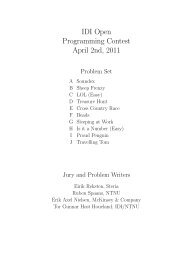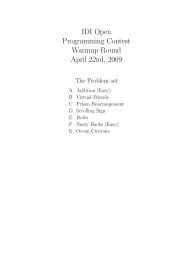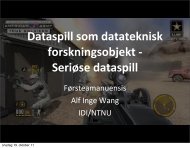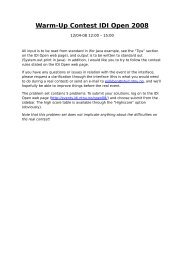<strong>of</strong> a commercial bank. The main motivation <strong>of</strong> this case study was to (1) discover multitaskingbehavior <strong>of</strong> the team members <strong>and</strong> (2) discover team <strong>inter</strong>action patterns. Theteam was integrated by 4 programmers (Gonçalo, Carla, Catarina, Alex<strong>and</strong>re) <strong>and</strong> theproject leader (Mariana). During the observation, the team performed tasks on the followingapplications; (1) Suppliers, (2) Claims, (3) Clients’ Mail Correspondence (calledMail application), (4) Evictions <strong>and</strong> (5) Marketing Campaigns. In this case, a three-weekobservation was conducted, where over 650 actions were collected. A second case studywas conducted within a purchasing center team <strong>of</strong> a furniture retail store. This case wasmotivated by the need <strong>of</strong> further improving a set <strong>of</strong> performance metrics. Five members,all performing similar activities, integrated the team. In this case, a three-week observationperiod was conducted, where 711 actions were collected.Fig. 3. A Context-Based ApproachApproach Activities. Our approach encompasses six activities; (1) bootstrapping, (2)action capture, (3) context discovery, (4) context visualization (5) context-based analysis<strong>and</strong> (6) context integration. Figure 3 depicts an overview <strong>of</strong> the approach activities. Inthis section we describe <strong>and</strong> illustrate them it with examples from our first case study.1. Bootstrapping: Our basic building blocks are agent, action <strong>and</strong> resource types.Agent types are <strong>individual</strong>s or teams. The following action set is an example set <strong>of</strong> actiontypes identified in one <strong>of</strong> our case studies: accept, analyze, answer, ask assist, calculate,discuss, elaborate, evaluate, find, help, inform, install, modify, print, program,promise, propose, reject, remind, request, research, send, solve, supervise, test, update.Resource types include formal information items such as documents, informal informationitems such as suggestions, ideas, facts, etc. Another type <strong>of</strong> resource are the toolsemployed in performing each action, which in the organizational environments we haveaddressed, are mainly composed <strong>of</strong> s<strong>of</strong>tware tools. The basic set <strong>of</strong> action <strong>and</strong> resourcetypes is defined after a brief observation period. The basic set is discussed <strong>and</strong> validatedby the observed subjects. The collection <strong>of</strong> actions is started with this basic set, but it canbe extended through the acquisition process.2. Capturing <strong>and</strong> Structuring Actions: Traditional modeling approaches describetasks, activities or processes with predicates (e.g. sell car, buy book, fill form). Thesedescriptions lack the subject. We register actions in chronological order, <strong>and</strong> describedthrough what we have defined as organizational sentences [5]. Organizational sentences(depicted in figure 4) are triples subject-verb-object, where the subject identifiesagents, the verb identifies the action type <strong>and</strong> the object identifies the resources used orproduced by the subject performing the action. (e.g. Gonçalo solve problem in SuppliersApplication). Communicative actions are further structured using speech theory
[13]. Speech acts are composed <strong>of</strong> a propositional content <strong>and</strong> the intention <strong>of</strong> the senderon that proposition. Communicative actions implicate the execution <strong>of</strong> another action(which can also be a communicative action). In other words, communications actionshave always embedded another action. In our approach, communicative actions took theform subject-verb-action. For example, Mariana request (Gonçalo solve problem inSuppliers Application).Fig. 4. The structure <strong>of</strong> ActionsThe object <strong>of</strong> organizational sentences may include several noun(s) (or noun phrases)including not only informational resources but also <strong>of</strong> auxiliary tools used in performingthe action. All the collected actions fitted within the present structure. Most complex actionsfound where two-level communicative actions, i.e. communicative actions embeddinganother communicative action e.g. “Alex<strong>and</strong>re request Mariana to ask MaintenanceChief who is responsible for the cards application”, which has the followingstructure: Alex<strong>and</strong>re request (Mariana ask (Maintenance Chief answer who isresponsible for the cards application).Table 1. Characteristics <strong>of</strong> Carla’s Common Services Application contextObject KeywordsContext Action informational resources or implicated tasks tools human resourcesc1 program common services applicationvisual studio dotnet,sqlserver, msdn, googlec1 discuss technological issues, common services application pedro, mariana3-4. Context Discovery <strong>and</strong> Visualization. We discover <strong>personal</strong> contexts accordinglyto our definition; grouping together action threads with similar resource sets <strong>of</strong> single<strong>individual</strong>s. Each grouping is shown to their owners, who validate <strong>and</strong> label them.Table 1 depicts the most representative actions <strong>and</strong> resources <strong>of</strong> the context c1 <strong>of</strong> Carla(Common Services Application Programming), as well as its associated set <strong>of</strong> informationalresources, tools <strong>and</strong> human resources. Subjects validate (<strong>and</strong> maybe regroup) <strong>and</strong>label groupings using the information provided in this table. Table 2 depicts some labeled<strong>personal</strong> contexts <strong>of</strong> Alex<strong>and</strong>re, Carla, Mariana <strong>and</strong> Gonçalo.







